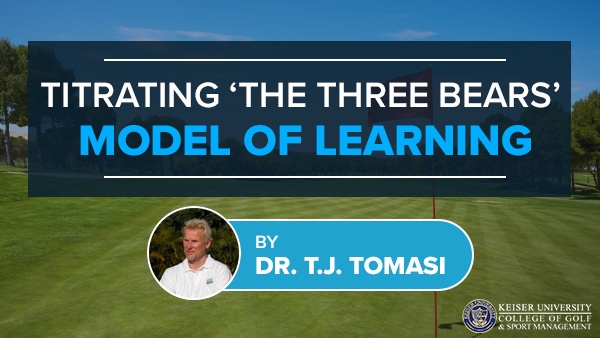Titrating ‘The Three Bears’ Model of Learning

by Dr. T. J. Tomasi, Keiser University College of Golf Senior Faculty and Director of Research
In the early stages of learning golf, don’t try for the perfection of the parts of the swing such as grip, weight shift, or release – initial learning is more like hand grenades than horseshoes where all you need to be is in the ballpark to get the job done. Once the form of the swing motion is installed, your brain will make continual upgrades to the motion as it approaches correctness. I call this The Three Bears model of learning – too hot, too cold, just right –i.e., the process of making adjustments that deliver improvement, most often with a teacher as a facilitator.
Running Your Own Brain:
Once you have defined the problem of building a swing, your brain chooses a set of modifications to your current swing that best meets the parameters of the solution you have chosen — for example, you modify your grip to curve the ball right to left. You keep adjusting the angle of attack until you produce the results you want. The learning sets are not random or arbitrary as they are when you simply tinker – they are carefully vetted. This is why the most successful golfers have teachers, and most successful people, in general, have role models and mentors. It is essential to vet your learning sets correctly since they are the basis for subsequent learning. Good learners have multi-set profiles from which to choose (sometimes called simply ‘experience’). And implementation becomes the easy part once the profiles are in-house. Slow learners have few learning sets, and because they lack options, they are doomed to repeat their mistakes. Slow learners can’t bracket because they are always lacking two of the three bears! A shot to the right of the target is simply a failure, whereas, for a good learner, it’s a piece of information that allows the correct alteration to the learning set. The Three Bears solution arises from the brain’s dialogue between your prefrontal cortex and the hippocampus. This dialogue compares your past solutions to the current problem so you can update your response. You already know how to hit a stock 7- iron from past experience, but the one you are facing now is from a sandy lie with a right-to-left wind. It’s the correct assessment of these new requirements and the adjustments you make and then store that determines your success, i.e., your current ¾ 7-iron swing comes from past profiles but is just different enough to require a new profile. Thus, as you play golf, your concept base becomes more and more global, allowing you to solve increasingly complex and diverse problems – you become a prime-time Point A to Point B problem solver with a tool kit of multi-set profiles. Congratulations – you’re a player!

Pictured above is Tiger Woods – one of the best golf brains ever; stored in there is almost every experience one can have.
If you’d like to study with Dr. Tomasi and other PGA Master Professionals, contact The College of Golf today.












